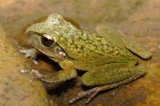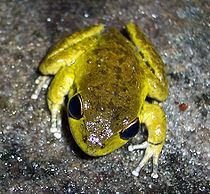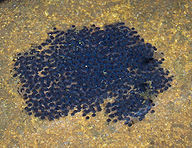
Lesueur's Frog
Encyclopedia

Tree frog
Hylidae is a wide-ranging family of frogs commonly referred to as "tree frogs and their allies". However, the hylids include a diversity of frog species, many of which do not live in trees, but are terrestrial or semi-aquatic.-Characteristics:...
native to south-eastern Australia
Australia
Australia , officially the Commonwealth of Australia, is a country in the Southern Hemisphere comprising the mainland of the Australian continent, the island of Tasmania, and numerous smaller islands in the Indian and Pacific Oceans. It is the world's sixth-largest country by total area...
, from Sydney, New South Wales to eastern Victoria
Victoria (Australia)
Victoria is the second most populous state in Australia. Geographically the smallest mainland state, Victoria is bordered by New South Wales, South Australia, and Tasmania on Boundary Islet to the north, west and south respectively....
.
Physical description
Lesueur's Frog is a moderately large sized frog, females of this species reach 7 centimetres (2.8 in), while males reach about 4.5 centimetres (1.8 in). It ranges from pale to dark brown above, however males in the breeding season become bright yellow. There is often darker patches on the back. There is a dark stripe that runs from the snout to the shoulder. The back of the legs are blue with black spots, this helps distinguish this species from the very similar Stoney Creek FrogStoney Creek Frog
The Stoney Creek Frog, is a ground dwelling tree frog , found in Eastern Australia.-Physical description:...
, (Litoria wilcoxi). The top half of the iris is pale and the bottom half dark. The toe discs are small and the belly is white.
Ecology and behaviour

An average of about 1630 eggs are laid in single clump loosely attached to bedrock in streams. The eggs are normally laid in still pools of streams. Hatching occurs up to a week after laying. Tadpoles reach about 4.5 centimetres (1.8 in), and are golden brown. Metamorphosis
Metamorphosis
Metamorphosis is a biological process by which an animal physically develops after birth or hatching, involving a conspicuous and relatively abrupt change in the animal's body structure through cell growth and differentiation...
occurs during summer and autumn, about 50-60 days after laying. Metamoprh frogs are small, about 1.4 centimetres (0.6 in) and resemble the adult, however the dark stripe on the head isn't very prominent.
In 2004 this species was divided into 3 separate species, with the Stoney Creek Frog
Stoney Creek Frog
The Stoney Creek Frog, is a ground dwelling tree frog , found in Eastern Australia.-Physical description:...
(Litoria wilcoxi) north of Sydney and Litoria jungguy
Litoria jungguy
Litoria jungguy is a species of frog in the Hylidae family.It is endemic to Australia.Its natural habitats are subtropical or tropical moist lowland forests and rivers.It is threatened by habitat loss.-Source:...
in northern Queensland
Queensland
Queensland is a state of Australia, occupying the north-eastern section of the mainland continent. It is bordered by the Northern Territory, South Australia and New South Wales to the west, south-west and south respectively. To the east, Queensland is bordered by the Coral Sea and Pacific Ocean...
.

